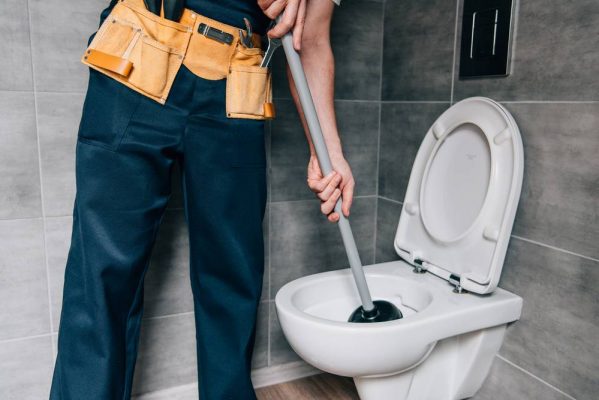We have stumbled upon this post relating to How to Unclog Your Sink with a Plunger below on the internet and figured it made good sense to share it with you on this site.

Introduction
Correct maintenance of household drains pipes is important for protecting against blockages and ensuring smooth water circulation. One of the secret devices in every house owner's toolkit is the plunger, along with different drain cleansers designed to take on stubborn obstructions efficiently. This article checks out how to utilize bettors and drain cleansers effectively to maintain your drains pipes flowing openly.
Section 1: Comprehending Bettors
Types of Plungers
There are a number of sorts of bettors available, each created for various types of drains and blocks. One of the most usual types include cup bettors, flange bettors, and accordion plungers.
Exactly How Plungers Work
Bettors work on the principle of developing stress and suction to dislodge clogs. When properly used over a drainpipe, they create a vacuum that can take out debris or separate obstructions.
Selecting the Right Plunger
Picking the ideal plunger relies on the kind of drainpipe and the nature of the blockage. Cup bettors are optimal for sinks and tubs, while flange bettors are better fit for toilets because of their design.
Typical Mistakes with Plungers
Staying clear of these errors makes certain effective plunging: inappropriate seal around the drainpipe, inadequate pressure, and unclear surrounding debris.
Area 2: Making Use Of Plungers Effectively
Preparation
Prior to diving, make certain the plunger covers the drain totally and develops a limited seal. Clear any kind of visible particles around the drain opening.
Method
Beginning with gentle diving activities to build suction. Boost stress gradually, utilizing a constant rhythm. Repeat as required up until the drainpipe gets rid of.
Troubleshooting Tips
If plunging doesn't function, attempt readjusting the seal, applying petroleum jelly for a much better seal, or utilizing a different sort of bettor.
Area 3: Comprehending Drain Cleansers
Kinds Of Drain Cleaners
Drain cleansers can be chemical or chemical. Chemical cleaners utilize solid chemicals to liquify clogs, while enzymatic cleansers make use of all-natural enzymes to break down raw material.
How Drain Cleansers Work
Chemical cleaners react with blockages to liquify them, while chemical cleaners break down organic materials like hair and grease without damaging pipelines.
Safety and security Considerations
Always use handwear covers and eye protection when utilizing chemical drain cleansers. Ensure sufficient air flow and adhere to producer directions meticulously.
Eco-Friendly Alternatives
Consider utilizing vinegar and baking soda or enzyme-based cleaners for environment-friendly alternatives that are safer for pipelines and the environment.
Section 4: Making Use Of Drain Cleansers Successfully
Application Methods
Pour chemical cleaners directly into the drainpipe opening. Permit them to work for the recommended time prior to flushing with warm water. Enzymatic cleaners ought to sit over night.
Preventative measures
Avoid blending various types of cleansers, as this can create toxic fumes. Never utilize chemical cleaners along with a bettor, as splashing can occur.
Taking Care Of Stubborn Obstructions
For consistent clogs, take into consideration utilizing a pipes serpent or calling a professional plumbing professional to prevent damage to pipes.
Final thought
To conclude, comprehending just how to make use of bettors and drainpipe cleaners successfully is important for keeping healthy and balanced plumbing systems. By picking the right tools and methods, property owners can tackle small blockages and protect against significant plumbing problems down the line.
How to Use a Plunger to Unclog a Drain
The humble plunger is a simple yet effective tool for breaking clogs in sinks, tubs and toilets. This handy tool is easy to use. You can make the most of its power if you understand how it works. Ready to dive in? Here’s what you need to know.
Safety First!
Never use a plunger with drain chemicals. Water will splash as you work, and the chemicals can spatter, burning skin and eyes. It’s a good idea to use rubber gloves and wear safety goggles when you work on a clog.
Choose the Right Tool for the Job
Plungers come in two different styles. Sinks, bathtubs and showers require a cup plunger. Like its name suggests, the rubber end is shaped like a cup. Use a flange plunger on toilets. These plungers have a rubber funnel extending from the cup. A plunger needs to be big enough to cover the drain.
Ready, Set, Plunge!
- Coat the rim: Coat the plunger rim with petroleum jelly. This helps make a better seal.
- Block outlets: Hold a wet rag over nearby outlets such as the overflow vent or the drain in a second sink.
- Release air: Insert the plunger at an angle into the water. Water will displace air in the cup. A water-filled cup is more forceful than one filled with air.
- Keep the plunger upright: Hold the plunger perpendicular to the drain. Use fast, forceful strokes, but make the first stroke gentle. The first stroke can create a splash if the cup still contains air. Thrust the plunger 15 to 20 times.
- Snap off the plunger: The final stroke should be a strong upward motion that ends when the plunger snaps off the drain.
- Repeat the process: you may need to repeat this sequence several times. When the water drains away, your work is done. High-five!
https://plumbernw.com/blog/how-to-use-a-plunger-to-unclog-a-drain/

We were shown that editorial on from a friend on a different web address. Be sure to take the time to distribute this blog post if you liked it. Thank you for taking the time to read it.
Call Today
Comments on “Utilizing Plunger and Drain Cleaners: Expert Tips”